Nora Rogers was a great teacher. She was a long time member of the Santa Cruz Handweavers Guild and, always, a major contributor. She died November 2010 after fighting cancer for two and a half years.

"Nora Rogers 2009" Photo: B.Nitzberg
Nora’s Textiles
My friendship with Nora developed quickly when we found out we were both passionate about card weaving. In earlier years Nora had explored different styles of card weaving and I had just begun. She knew threaded designs, double-faced and Icelandic designs, as well as spaced card weaving[TWIST,Hamamura]. She had studied the archaeological finds and interpreted them in her own contemporary style. We spoke the same language.
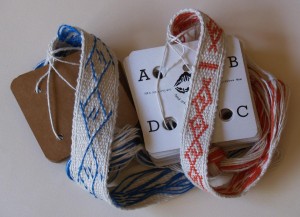
One pattern- two techniques Photo: G. Polak
Typical card weaving is a special form of warp twining. There are many other ways to twine threads that do not involve cards. It is either the warp or the weft that is twined, or the warp becomes weft becomes warp again while the threads run diagonally. Twining is found in textiles and baskets. Spaced-weft twining of ancient Peruvian textiles and the structures of Western Great Lakes Storage Bags caught Nora’s attention and imagination. She created many wall pieces with patterns of geometric designs and mythical figures. It is an unusual technique and she loved it[Spaced-weft Twining of Ancient Peru]. She taught a workshop to the braiders group and published a tutorial that is still available on the Santa Cruz Handweavers Guild website.
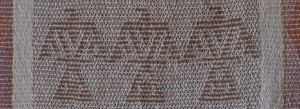
Spaced weft twining Photo: G.Polak
While card weaving and twining were the focus of her earlier years she developed an intense interest in braiding and plaiting in later years. Here again, her inspiration came from ethnic textiles like the arrow sashes of the Native American Northeast and Paracas Headbands of Peru [Mary Frame]. Diagonal movement of groups of threads is the essential method to create patterns in her braided tapestries.
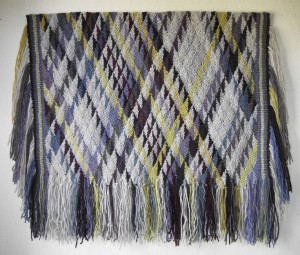
Braided tapestry Photo: N. Rogers
A preference for this technique is one of several that she shared with her friend Barbara Nitzberg. Barbara recalls:
Nora made many beautiful textiles, drawing on her studies of ancient cultures for inspiration, but her real legacy for me is the example she set of curiosity going hand-in-hand with scholarship and meticulous documentation. Structure, both understanding and exploring, was the connecting point for Nora and me, and I expect my conversations with Nora will long continue.
Visit Gallery 28 on Janis Saunders’ weavershand.com to see more of her braided tapestries.
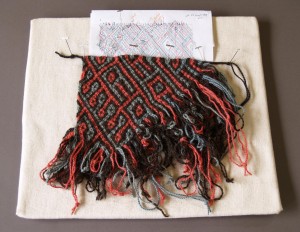
Unfinished Braid Photo: G. Polak
Her Role in our Guild
A friendship of more than 30 years connected Nora with Martha Stanley. Martha remembers:
Nora was always quite the scholar. She knew a great deal about the many Native American weaving traditions of both North and South America.
Although she had a floor loom, her love was braiding, diagonal plaiting. And some of her most beautiful work came after her diagnosis of cancer. The braids were her chemotherapy, keeping her alive and vividly engaged.
May we all be as curious and enthralled with our weavings as she was with hers.
Nora and Martha are both well known for their own exceptional work. But there is more. In a beautiful collaboration with nine other contributors they created In Celebration of the Curious Mind, a Festschrift to honor Anne Blinks on her 80th birthday. The essays and articles of this book shine a light on many forgotten or little understood aspects of the world of textiles. Do you know sprang? Why is some wool naturally brown or black? And what exactly is Saha Weave? The authors’ deep knowledge make this collection an outstanding accomplishment and a fascinating read.
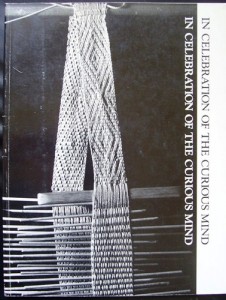
Festschrift to honor Anne Blinks
During the first years of her retirement Nora took on the task of creating the “Anne Blinks Collection” (AB Collection). Anne Blinks had collected and created unusual textiles over many years of her life, most of them in mysterious techniques and very special yarns. Anne revived and showed the magic of overspun S and Z singles long before collapse weave came to mainstream handweaving. If you don’t know what a Roggeband is and how to use an inkle loom to weave one, check out the page Exploring the Roggeband.
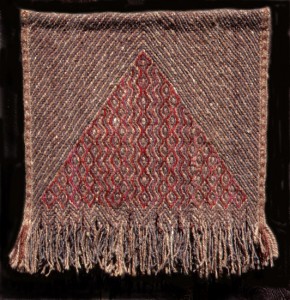
'Pyramid' - card woven tapestry Photo: N. Rogers
Nora spearheaded the effort of evaluating those textiles, analyzing, and categorizing them. The purpose was to make the AB Collection available to study groups no matter where they are. Documentation was published on the website where it still is today and boxes are still available for check out.
A Collection as Inspiration
Several months ago I was given a box containing samples of Nora’s textiles. Many of them are card weaving, some are knitting, some are crocheting, some are braiding, and then there are other mysterious interlacements.
Samples from other artists are included. Most of them are by Lillian Elliott but there are other unknown contributors as well. The styles vary and we can only speculate about the origins of each piece.
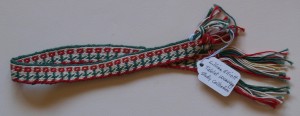
Lillian Elliott's Flower Band Photo: G. Polak
For textile artists with a “curious mind” this collection is a treasure. As I examine some samples I am compelled to reproduce several bands just to convince myself that my guess work is correct. As a reward I come up with new ideas in card weaving – I thought I had seen it all. Be it card weaving or crocheting there is always yet another way to intertwine the threads and solve mysteries.
Nora must have experienced the same when she studied old textiles. Her own words are:
Learning one new (actually old) technique often creates a whole new set of possibilities for the contemporary weaver – the multiple dimensions, the process, the opportunities for discovery are both exhilarating and satisfying. A connection with the past provides development of new ideas and new processes for the future.
Nora’s influence, knowledge, and spirit were important to us then and today. Now the time has come to pass this collection on to you so you can make your own discoveries. At CNCH, I will present the collection in the TWIST meeting and in the demonstration area. Come and learn.
Links:
Santa Cruz Handweavers Guild(www.santacruzhandweavers.org)
Anne Blinks Collection (www.santacruzhandweavers.org/anneblinks)
Twining Tutorial (www.santacruzhandweavers.org/twining/demo2007/index.shtml)
Gallery at Weavershand (www.weavershand.com/kgallery28.html)
“warp and weft”, Robin and Russ, Volume XXXIV, No 5 (www.cs.arizona.edu/patterns/weaving/periodicals/ww_34_05.pdf)
References and Publications:
John and Susan Hamamura: Woven Works. Chronicle Books/San Francisco, page 45
Nora Rogers: Spaced-weft Twining of Ancient Peru. A Contemporary Interpretation. Interweave, Fall 1980.
Nora Rogers: A Response to Russel Groff – 21 Years Later. TWIST Volume IX Issue 2
Nora Rogers, Martha Stanley (Editors): In Celebration of the Curious Mind, Interweave Press, 1983
Mary Frame: Structure, Image, and Abstraction Paracas Neocropolis Headbands as System Templates, Paracas Art and Architecture, Edited by Anne Paul, University of Iowa Press, 1991,page 110 – 171.